1988 PONTIAC FIERO belt
[x] Cancel search: beltPage 1780 of 1825
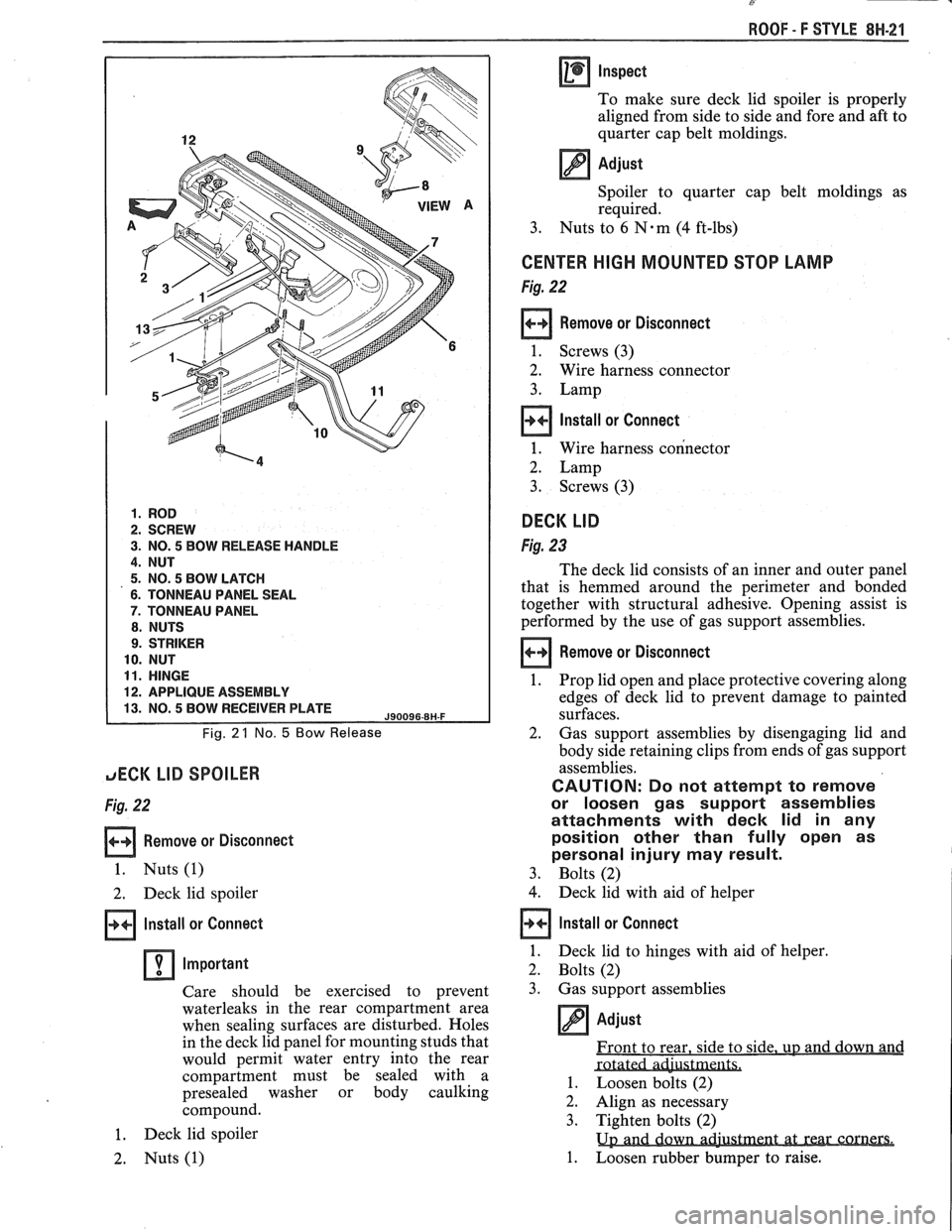
ROOF - f STYLE 8N-21
1. ROD
2. SCREW
3. NO. 5 BOW RELEASE HANDLE
4. NUT
5. NO. 5 BOW LATCH
6. TONNEAU PANEL SEAL
7. TONNEAU PANEL
8. NUTS
9. STRIKER
10. NUT
11. HINGE
12. APPLIQUE ASSEMBLY
Fig. 2 1 No. 5 Bow Release
JECK LID SPOILER
Fig. 22
Remove or Disconnect
1. Nuts (1)
2. Deck lid spoiler
Install or Connect
Important
Care should be exercised to prevent
waterleaks in the rear compartment area
when sealing surfaces are disturbed. Holes
in the deck lid panel for mounting studs that
would permit water entry into the rear
compartment must be sealed with a
presealed washer or body caulking
compound.
1. Deck lid spoiler
2. Nuts (1)
Inspect
To make sure deck lid spoiler is properly
aligned from side to side and fore and aft
to
quarter cap belt moldings.
Adjust
Spoiler to quarter cap belt moldings as
required.
3. Nuts to
6 N.m (4 ft-lbs)
CENTER HIGH MOUNTED STOP LAMP
Fig. 22
Remove or Disconnect
1. Screws (3)
2. Wire harness connector
3. Lamp
Install or Connect
1. Wire harness connector
2. Lamp
3. Screws (3)
DECK LID
Fig. 23
The deck lid consists of an inner and outer panel
that is hemmed around the perimeter and bonded
together with structural adhesive. Opening assist is
performed by the use of gas support assemblies.
Remove or Disconnect
1. Prop
lid open and place protective covering along
edges of deck lid to prevent damage to painted
surfaces.
2. Gas support
assemblies by disengaging lid and
body side retaining clips from ends of gas support
assemblies.
CAUTION: Do not attempt to remove
or loosen gas support assemblies
attachments with deck lid in any
position other than
fully open as
personal injury may result.
3. Bolts (2)
4. Deck lid with aid of helper
Install or Connect
1.
Deck lid to hinges with aid of helper.
2. Bolts (2)
3. Gas support assemblies
2. Align as necessary
3. Tighten bolts (2)
1. Loosen rubber bumper to raise.
Page 1781 of 1825
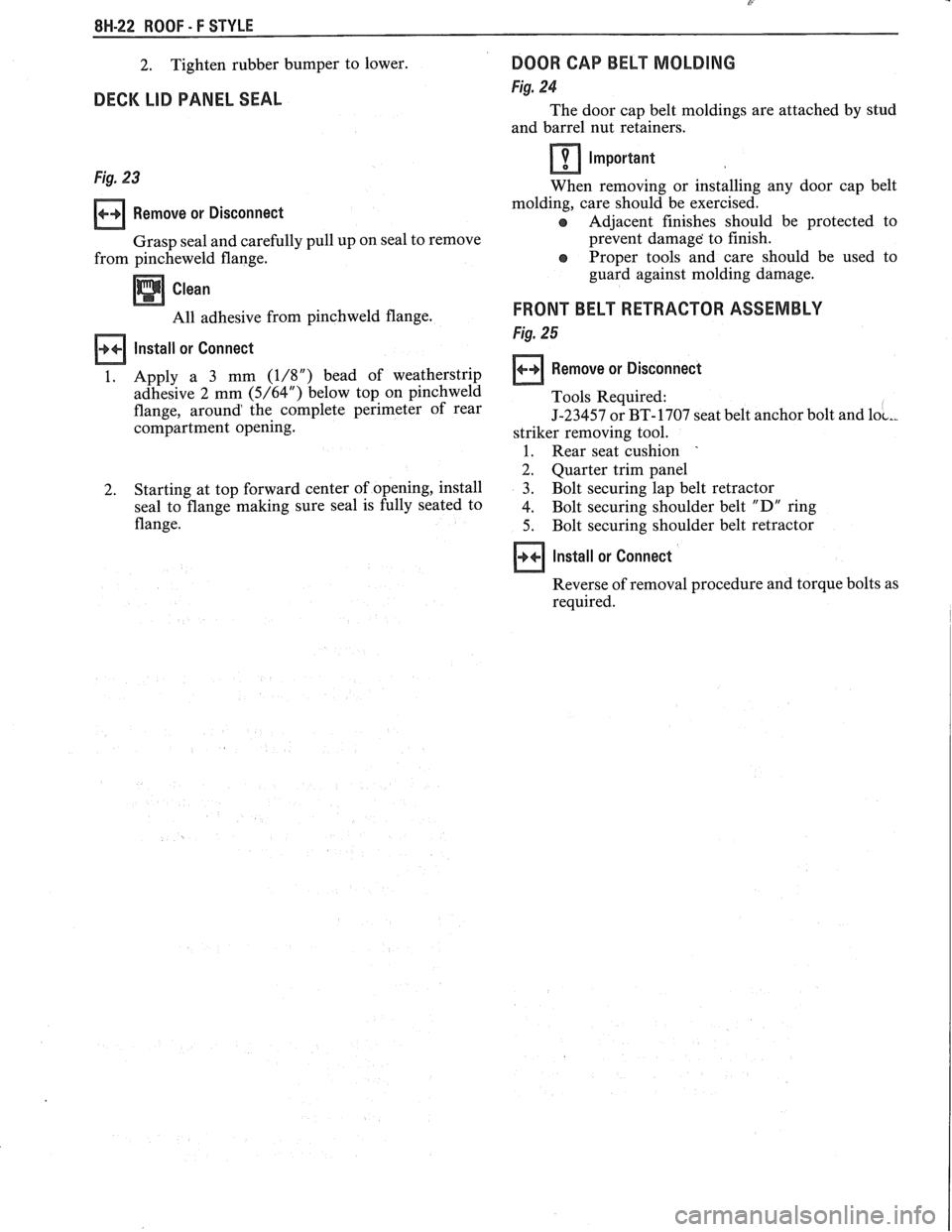
8W-22 ROOF - F STYLE
2. Tighten rubber bumper
to lower.
DECK LIB PANEL SEAL
Fig. 23
Remove or Disconnect
Grasp seal and carefully pull up on seal to remove
from pincheweld flange.
Clean
All adhesive from pinchweld flange.
Install or Connect
1.
Apply a 3 mm (1/8") bead of weatherstrip
adhesive 2 mm
(5/64") below top on pinchweld
flange, around the complete perimeter of rear
compartment opening.
2. Starting at top forward center of opening, install
seal to flange making sure seal is fully seated to
flange.
DOOR CAP BELT MOLDING
Fig. 24
The door cap belt moldings are attached by stud
and barrel nut retainers.
Important
When removing or installing any door cap belt
molding, care should be exercised.
s Adjacent finishes should be protected to
prevent damage' to finish.
Proper tools and care should be used to
guard against molding damage.
FRONT BELT RETRACTOR ASSEMBLY
Fig. 25
Remove or Disconnect
Tools Required:
J-23457 or BT-1707 seat belt anchor bolt and
lo^-_
striker removing tool.
1. Rear seat cushion '
2. Quarter trim panel
3. Bolt securing
lap belt retractor
4. Bolt
securing shoulder belt
"D" ring
5. Bolt
securing shoulder belt retractor
Install or Connect
Reverse of removal procedure and torque bolts as
required.
Page 1783 of 1825
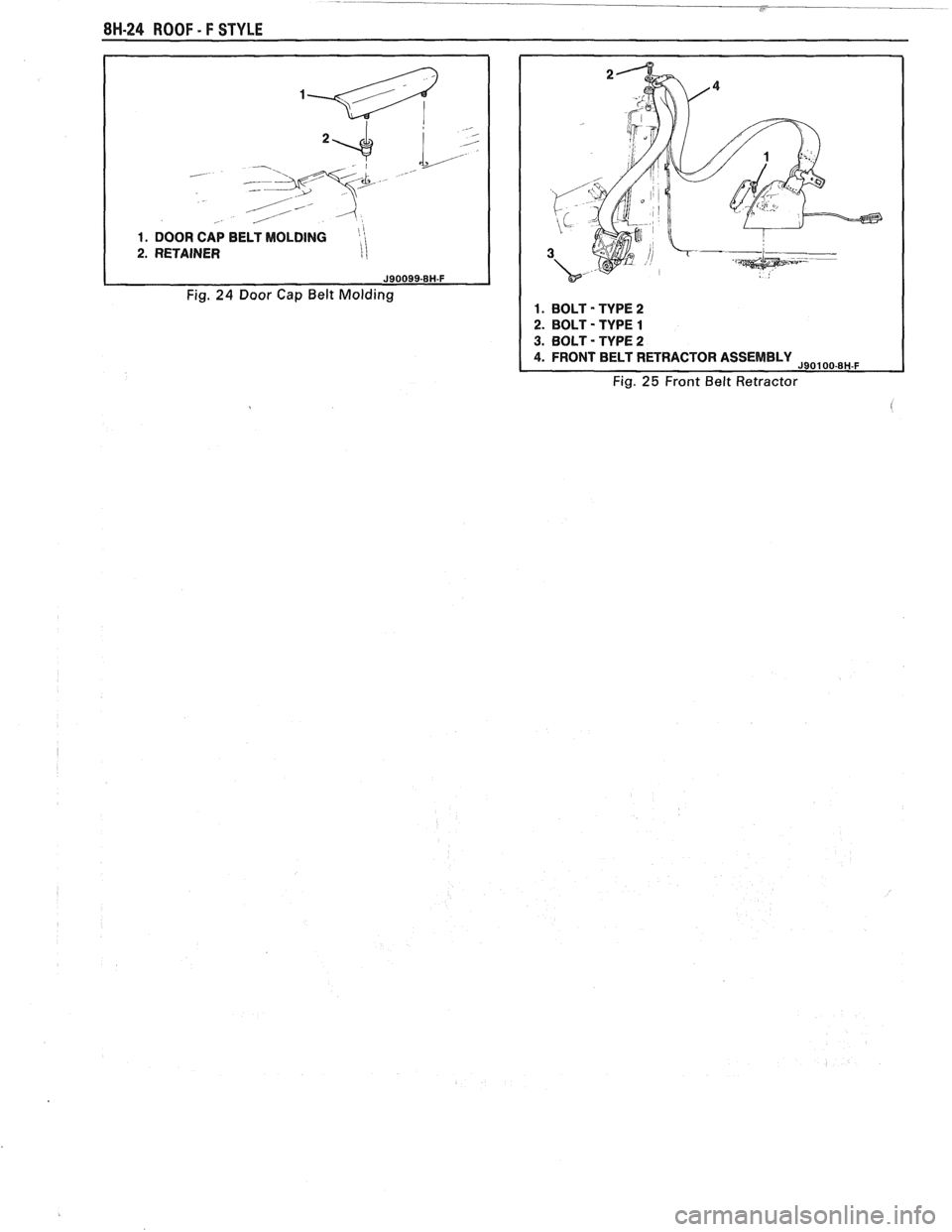
8H.24 ROOF - F STYLE
1. DOOR CAP BELT MOLDING ''
2. RETAINER I
Fig. 24 Door Cap Belt Molding 1. BOLT - TYPE 2
2.
BOLT - TYPE 1
3. BOLT - TYPE 2
4. FRONT BELT RETRACTOR ASSEMBLY J90100-8H-F
Fig. 25 Front Belt Retractor
t
Page 1784 of 1825

SEATS - F STYLE 9H-1
SEC"IC"0N 9H
SEATS
NOTICE: Lap belt to floor pan and shoulder belt to roof panel or quarter panel fasteners are important
attaching parts in that they could affect the performance of vital parts and systems, and/or could result in major
repair expense. They must be replaced with one of the same part number or with an equivalent part if replacement
becomes necessary. Do not use a replacement part of lesser quality or substitute design. Torque values must be
used as specified during reassembly to assure proper retention of these parts.
CONTENTS
Restraint Systems ........................................... 9H- 1
Lap and Shoulder Belts
............................... 9H-1
Comfort Lock Operational Checks
and Requirements
.................................... 9H- 1
Front Seat Shoulder Belt Retractor
............ 9H-2
Child Seat
...................................................... 9H-2
............................... .................. -.rant Seats .. 9H-5
Mead Restraint
............................................. 9H-5
Reclining
Seatback ................................... 9H-6
Front
Seatback ........................................... 9H-7
Inertia Lock Check
...................................... 9H-7
............................... Manual Recliner Check 9H-7
........................... Seat Torque Specifications 9H-8
Manual Seat
- Diagnosis Chart ................... 9H-8
..................... Power Seat - Diagnosis Chart 9H-9
RESTRAINT SYSTEMS
LAP
AND SHOULDER BELTS
The front seat belts incorporate a 4-to-8 second
fasten seat belt reminder lamp and sound signal
designed to remind the driver if the lap and shoulder
belts are not fastened when the ignition is turned to the
on position. If the driver's seat belt
is buckled, the
alarm will not operate; however, the fasten seat belt
xminder lamp will stay on for a 4-to-8 second period.
,, the driver's seat belt is not buckled, the reminder
lamp and sound signal will automatically shut off after
the 4-to-8 second interval. To diagnose a system
failure, refer to Seat Belt Reminder
Lamp/Alarm
Diagnosis in Section 8A.
The shoulder belt is attached to the front seat lap
belt latch plate and connected to an inertia locking
retractor installed to the roof panel above the right and
left side of the front seat. The shoulder belt remains
unlocked to allow the occupants to move freely while
the vehicle is being operated. When the vehicle
decelerates or changes direction abruptly, the shoulder
belt is locked in position by a pendulum that causes a
locking bar to engage a cog of the retractor mechanism.
The retractor has a comfort lock feature that
allows the occupant to adjust the shoulder belt for
proper fit and comfort. When engaged, the comfort
lock prevents full retraction of the webbing to eliminate
occupant discomfort due to webbing load on the
shoulder. The occupant can readjust the comfort lock
during vehicle operation as described below.
When servicing or replacing lap and shoulder
belts, refer to the following precautionary items: Front
Seat Adjustments
............................... 9H- 10
Manual Seat Control Arm Knob
................ 9H-10
Front Seat Assembly
.................................... 9H- 1 1
Seat Adjuster Assembly ............................. 9H-11
Six-way Seat Adjuster .................................. 9H- 12
Power Seat Switch
........................................ 9H-15
Four-way Manual Seat Adjuster
................. 9H-15
Seatback Lock Striker/Side Bar Stop .......... 9H-15
High Performance AQ9 Seat
(2FS87) ......... 9H-15
................. .................................... Rear Seats ... 9H- 19
........................................ Cushion Assembly 9H- 19
................................ Folding Rear Seatback 9H- 19
........................... Seatback Lock Assembly 9H-20
.................................. Seatback Lock Striker 9H-20
1. Lap and shoulder belts will be serviced as follows:
a. Retractor
portion(s) of
front seat lap and
shoulder belt for outboard passenger and
driver.
b. Buckle portion of front seat lap belt for
outboard passenger and driver.
c. All belts other than those mentioned in
above steps a and b will be serviced in
complete sets.
d. Do not intermix standard and deluxe belts
on front or rear seats.
2. Keep sharp edges and damaging objects away
from belts.
3. Avoid bending or damaging any portion of the
belt buckle or latch plate.
4. Do not bleach or dye belt webbing (clean with a
mild soap solution and water).
5. When installing lap or shoulder belt anchor bolt,
start bolt by hand to assure that bolt is threaded
straight.
NOTICE: See NOTICE on page 9H-1 of this
section.
6. Do not attempt repairs on lap or shoulder belt
retractor mechanisms or lap belt retractor covers.
Replace with new service replacement parts.
Comfort Lock Operational Checks and Requirements
The shoulder belt comfort lock feature must
function as follows:
1. Extend the webbing from the retractor to a
distance approximating buckled position.
Page 1785 of 1825
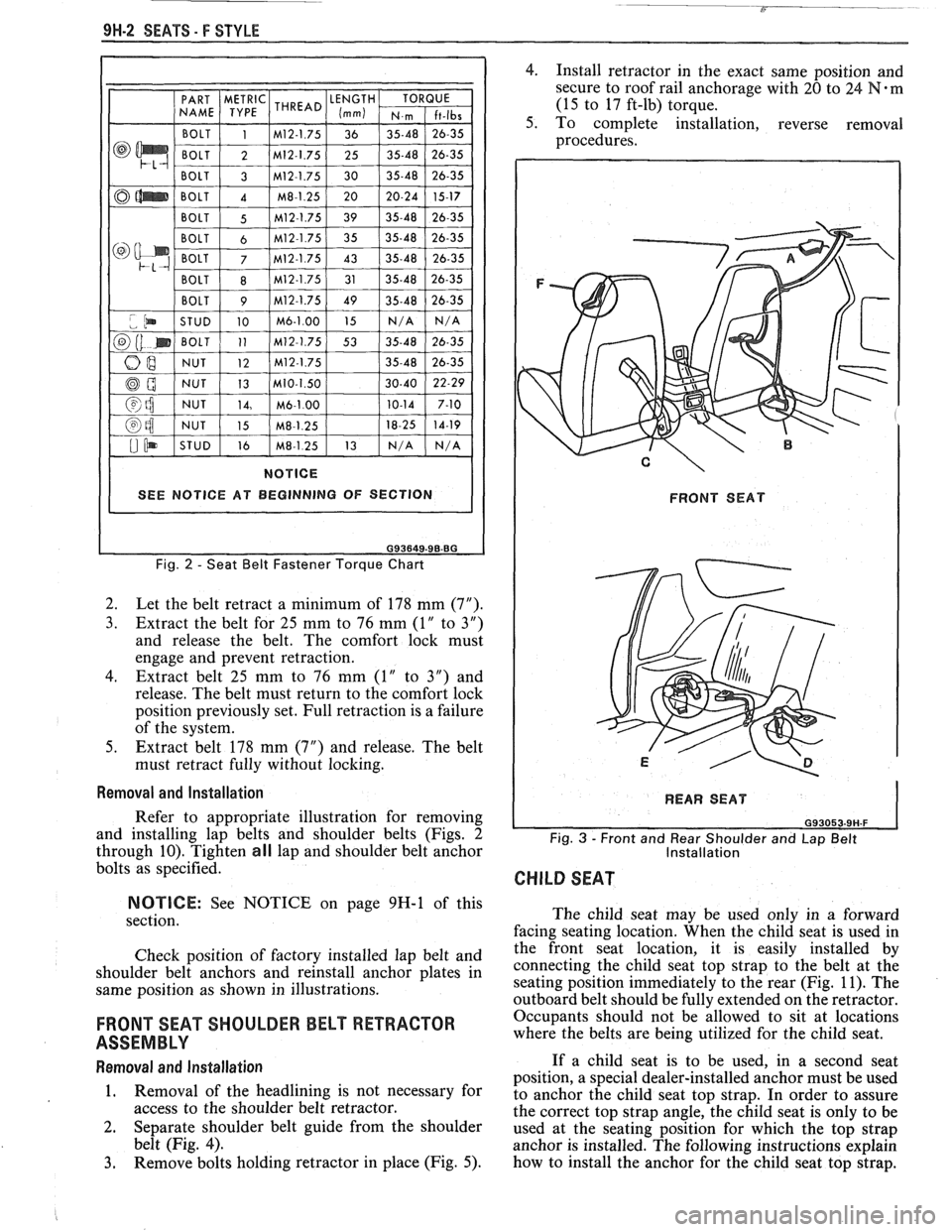
9H-2 SEATS - I: STYLE
Fig. 2 - Seat Belt Fastener Torque Chart
2.
Let the belt retract a minimum of 178 mm (7").
3. Extract the belt for 25 mm to 76 mm (1" to 3")
and release the belt. The comfort lock must
engage and prevent retraction.
4. Extract belt 25 mm to 76 mm (1" to 3") and
release. The belt must return to the comfort lock
position previously set. Full retraction is a failure
of the system.
5. Extract belt 178 mm (7") and release. The belt
must retract fully without locking.
Removal and Installation
Refer to appropriate illustration for removing
and installing lap belts and shoulder belts (Figs. 2
through 10). Tighten
all lap and shoulder belt anchor
bolts as specified.
NOTICE: See NOTICE on page 9H-1 of this
section.
Check position of factory installed lap belt and
shoulder belt anchors and reinstall anchor plates in
same position as shown in illustrations.
FRONT SEAT SHOULDER BELT RETRACTOR
ASSEMBLY
Removal and Installation
1. Removal
of the headlining is not necessary for
access to the shoulder belt retractor.
2. Separate shoulder belt guide from the shoulder
belt (Fig. 4).
3. Remove bolts holding retractor in place (Fig. 5).
4. Install retractor in the exact same position and
secure to roof rail anchorage with 20 to
24 Fd-m
(15 to 17 ft-lb) torque.
5. To complete installation, reverse removal
procedures.
FRONT SEAT
I REAR SEAT 1
Fig. 3 - Front and Rear Shoulder and Lap Belt
Installation
CHILD SEAT
The child seat may be used only in a forward
facing seating location. When the child seat is used in
the front seat location, it is easily installed by
connecting the child seat top strap to the belt at the
seating position immediately to the rear (Fig. 11). The
outboard belt should be fully extended on the retractor.
Occupants should not be allowed to sit at locations
where the belts are being utilized for the child seat.
If a child seat is to be used, in
a second seat
position, a special dealer-installed anchor must be used
to anchor the child seat top strap. In order to assure
the correct top strap angle, the child seat is only to be
used at the seating position for which the top strap
anchor is installed. The following instructions explain
how to install the anchor for the child seat top strap.
Page 1786 of 1825
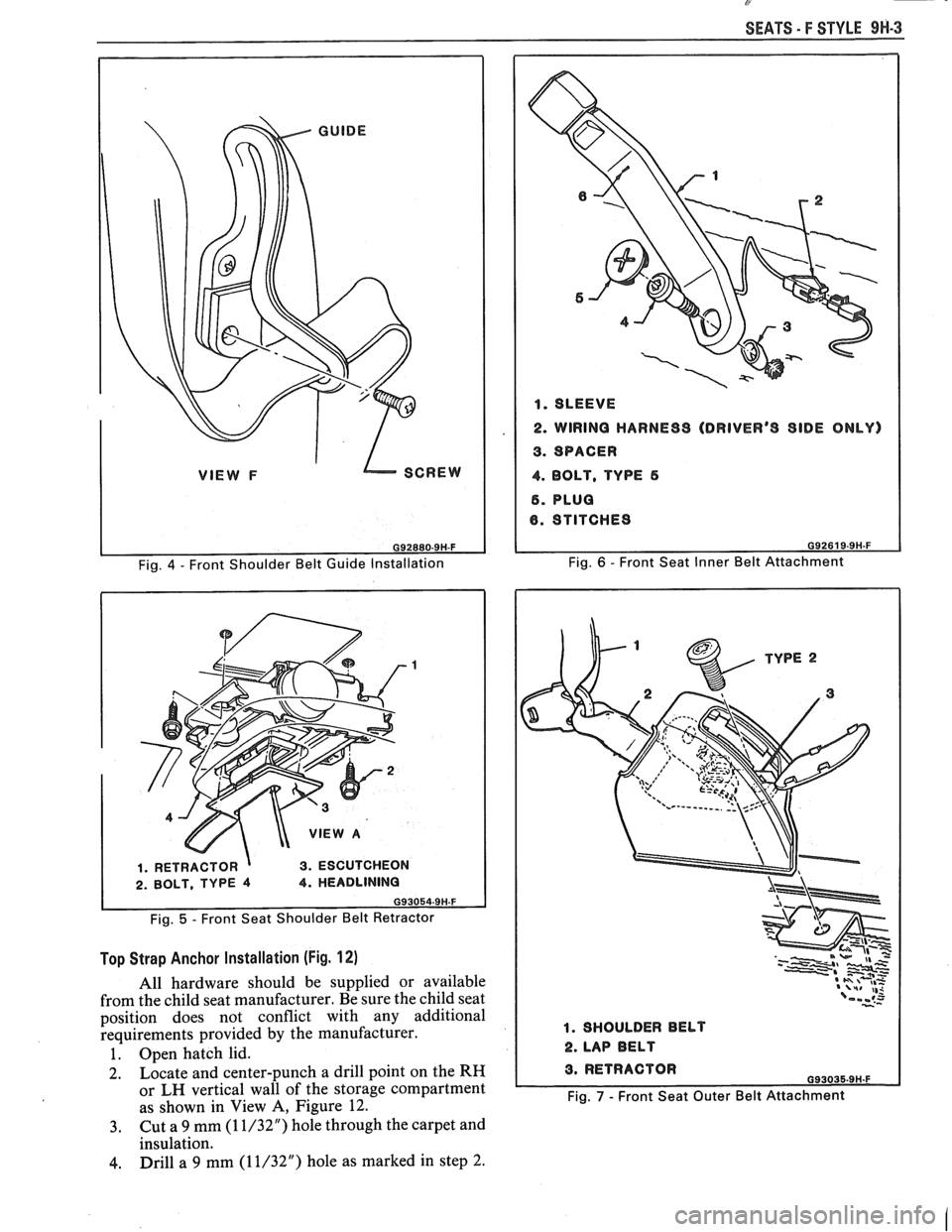
VlEVV F SCREW
Fig. 5 - Front Seat Shoulder Belt Retractor
Top Strap Anchor Installation (Fig. 12)
All hardware should be supplied or available
from the child seat manufacturer. Be sure the child seat
position does not conflict with any additional
requirements provided by the manufacturer.
1. Open hatch lid.
2. Locate
and center-punch a drill point on the
RH
or LH vertical wall of the storage compartment
as shown in View A, Figure 12.
3. Cut a 9 mm (1 1/32") hole through the carpet and
insulation.
4. Drill a 9 mm (1 1/32") hole as marked in step 2.
SEATS - F STYLE 9H-3
1. SLEEVE
2. WIRING HARNESS (DRIVER" SIDE ONLY)
3. SPACER
4. BOLT, TYPE 5
6. PLUQ
8. STITCHES
09261 9.9H-F
Fig. 6 - Front Seat Inner Belt Attachment
1. SHOULDER BELT
2. LAP BELT
Fig. 7 - Front Seat Outer Belt Attachment
Page 1787 of 1825
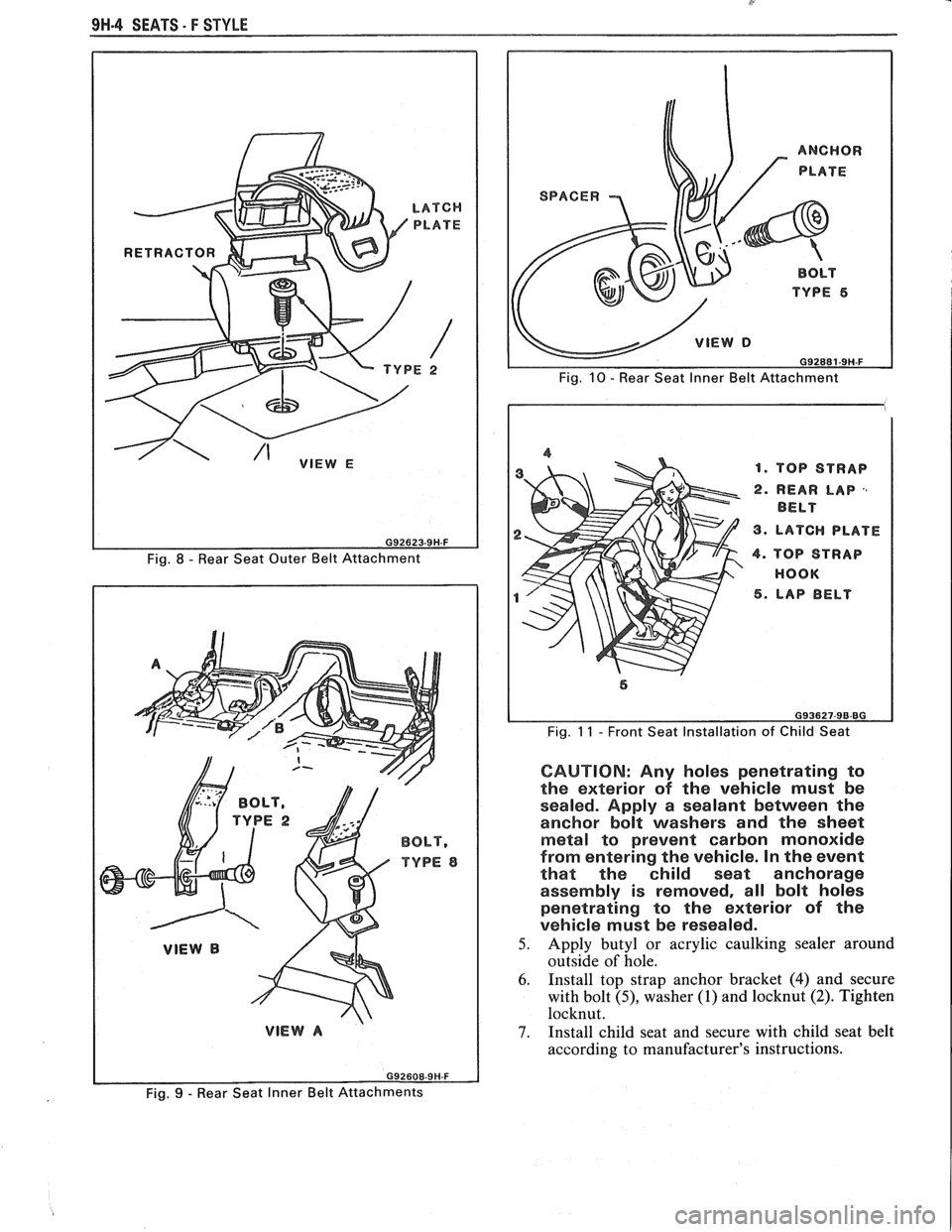
9H-4 SEATS - F STYLE
Fig. 8 - Rear Seat Outer Belt Attachment
BOLT,
TYPE 8
TOP STRAP
REAR LAP
,,
BELT
LATCH PLATE
TOP STRAP
HOOK LAP BELT
Fig. 11 - Front Seat Installation of Child Seat
CAUTION: Any holes penetrating to
the exterior of the vehicle must be
sealed. Apply a sealant between the
anchor bolt washers and the sheet
metal to prevent carbon monoxide
from entering the vehicle. In the event
that the child seat anchorage
assembly is removed, all bolt holes
penetrating to the exterior of the
vehicle must be resealed.
5. Apply butyl or acrylic caulking sealer around
outside of hole.
6. Install top strap anchor bracket (4) and secure
with bolt
(9, washer (1) and locknut (2). Tighten
locknut.
7. Install child seat and secure with child seat belt
according to manufacturer's instructions.
Fig. 9 - Rear Seat Inner Belt Attachments
Page 1791 of 1825
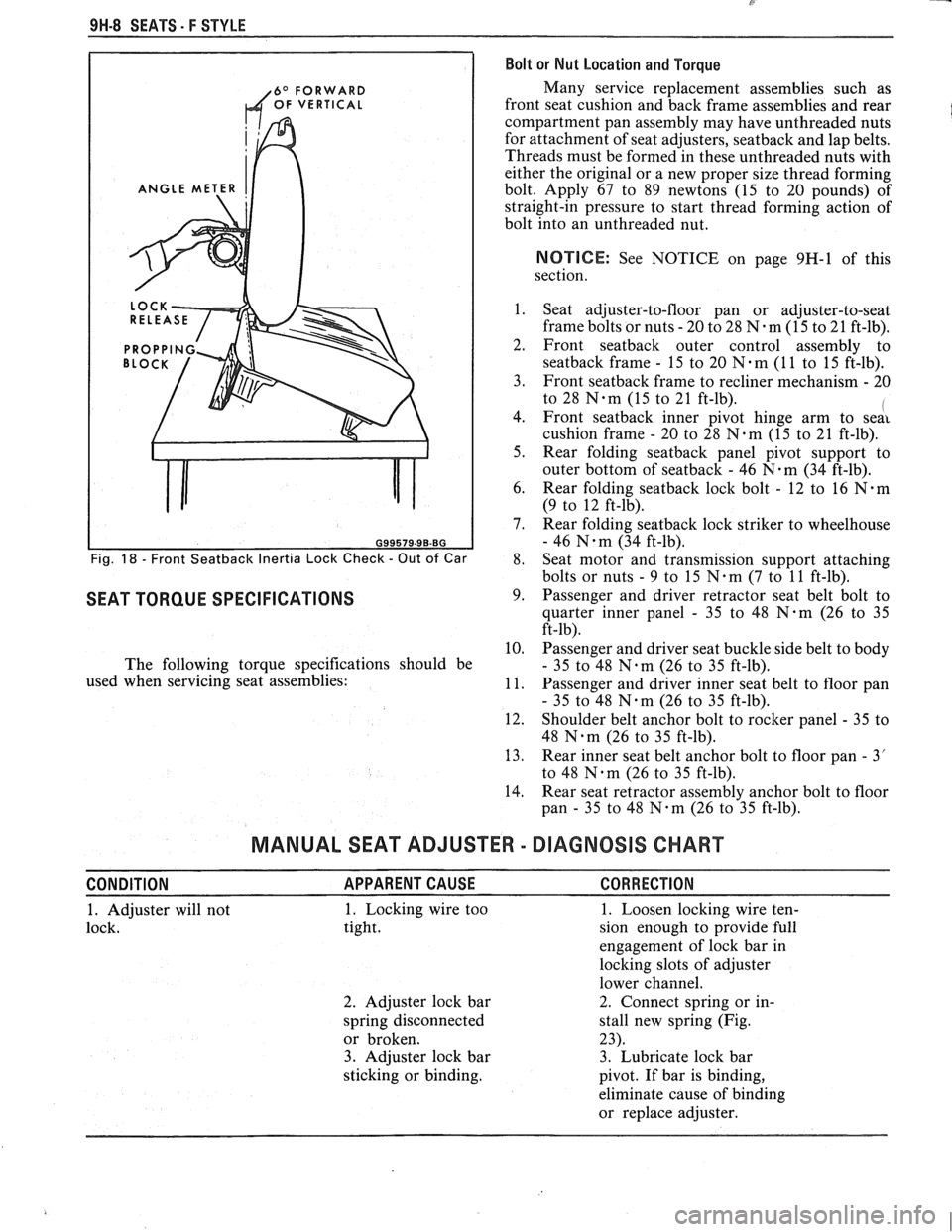
9H-8 SEATS. F STYLE Bolt or Nut Location and Torque
6O FORWARD Many service replacement assemblies such as
OF VERTICAL front seat cushion and back frame assemblies and rear
compartment pan assembly may have unthreaded nuts
for attachment of seat adjusters,
seatback and lap belts.
Threads must be formed in these unthreaded nuts with
either the original or a new proper size thread forming
ANGLE METER bolt. Apply 67 to 89 newtons (15 to 20 pounds) of
straight-in pressure to start thread forming action of
bolt into an unthreaded nut.
NOTIICE: See NOTICE on page 9H-1 of this
section.
1. Seat adjuster-to-floor pan or adjuster-to-seat
frame bolts or nuts
- 20 to 28 N-m (15 to 21 ft-lb).
2. Front seatback outer control assembly to
seatback frame - 15 to 20 N-m (1 1 to 15 ft-lb).
3. Front
seatback frame to recliner mechanism - 20
to 28
N-m (15 to 21 ft-lb). I 4. Front seatback inner pivot hinge arm to seai
cushion frame - 20 to 28 N.m (15 to 21 ft-lb).
5. Rear folding
seatback panel pivot support to
outer bottom of
seatback - 46 N-m (34 ft-lb).
6. Rear folding
seatback lock bolt - 12 to 16 N.m
(9 to 12 ft-lb).
7. Rear folding
seatback lock striker to wheelhouse
- 46 N.m (34 ft-lb).
Fig. 18 - Front Seatback Inertia Lock Check - Out of Car 8. Seat
motor and transmission support attaching
bolts or nuts
- 9 to 15 N.m (7 to 11 ft-lb).
SEAT TORQUE SPECIFICATIONS 9. Passenger and driver retractor seat belt bolt to
quarter inner panel
- 35 to 48 N-m (26 to 35
ft-lb).
10. Passenger and driver seat buckle side belt to body
The following torque specifications should be
- 35 to 48 N.m (26 to 35 ft-lb).
used when servicing seat assemblies:
11. Passenger and driver inner seat belt to floor pan
- 35 to 48 N.m (26 to 35 ft-lb).
12. Shoulder belt anchor bolt to rocker panel
- 35 to
48
Nam (26 to 35 ft-lb).
13. Rear inner seat belt anchor bolt to floor pan
- 3'
to 48
Nqm (26 to 35 ft-lb).
14. Rear seat retractor assembly anchor bolt to floor
pan
- 35 to 48 N-m (26 to 35 ft-lb).
MANUAL SEAT ADJUSTER - DIAGNOSIS CHART
CONDITION APPARENTCAUSE CORRECTION
1. Adjuster will not 1. Locking wire
too
1. Loosen locking wire ten-
lock. tight. sion enough to provide full
engagement of lock bar in
locking slots of adjuster
lower channel.
2. Adjuster lock bar 2. Connect spring or
in-
spring disconnected stall new spring (Fig.
or broken. 23).
3. Adjuster lock bar 3. Lubricate lock bar
sticking or binding.
pivot. If bar is binding,
eliminate cause of binding
or replace adjuster.